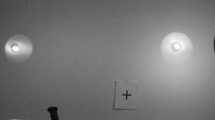Abstract
DURING the act of blinking the pupils are masked by the upper lids for an appreciable fraction of a second (c. 0·1–0·3 sec.) and, in consequence, vision is intermittent. The blackout index expresses the percentage of vision during which one is unsighted, and is obtained from the ratio of the blackout and interblink periods, the normal average value of the latter being for men and women c. 3·3 sec. In conversation, the average interblink period is only c. 2.7 sec.1.
Similar content being viewed by others
References
Hall, Sir Arthur, Brit. J. Ophthal., 29, 446 (1945).
Lawson, R. W., Nature, 161, 154 (1948).
Lord, Mary P., and Wright, W. D., Nature, 162, 25 (1948).
Author information
Authors and Affiliations
Rights and permissions
About this article
Cite this article
LAWSON, R. Photographic Evaluation of Blackout Indices. Nature 162, 531–532 (1948). https://doi.org/10.1038/162531a0
Issue Date:
DOI: https://doi.org/10.1038/162531a0
- Springer Nature Limited
This article is cited by
-
Limits of Human Vision
Nature (1961)





